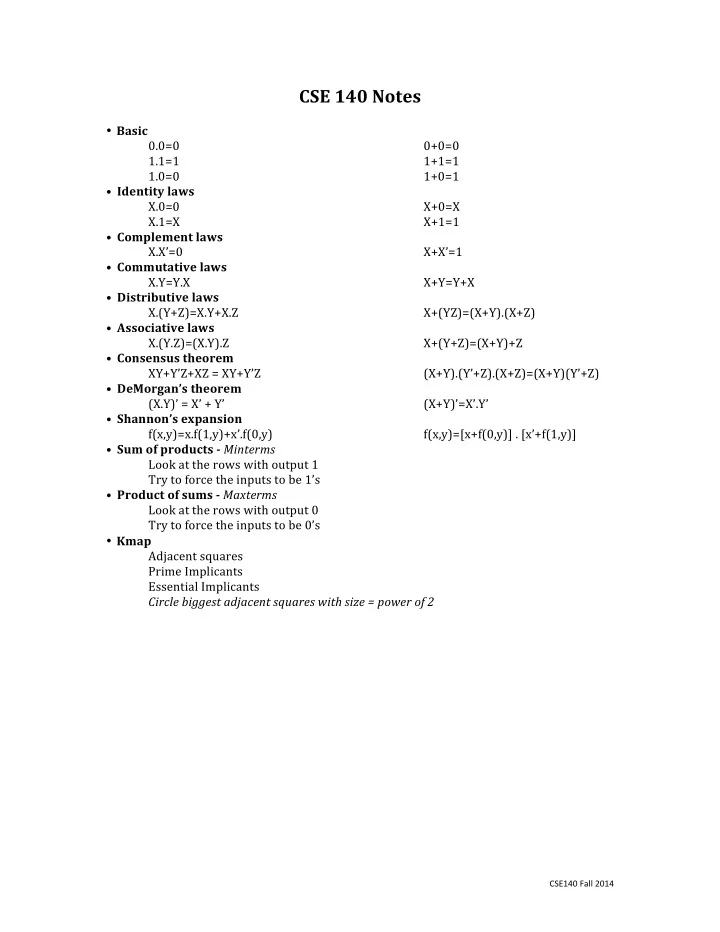

CSE ¡140 ¡Notes ¡ ¡ • Basic ¡ 0.0=0 ¡ 0+0=0 ¡ 1.1=1 ¡ 1+1=1 ¡ ¡ 1.0=0 ¡ 1+0=1 • ¡Identity ¡laws ¡ X.0=0 ¡ X+0=X ¡ X.1=X ¡ X+1=1 ¡ ¡ • ¡Complement ¡laws ¡ X.X’=0 ¡ X+X’=1 ¡ • ¡Commutative ¡laws ¡ X.Y=Y.X ¡ X+Y=Y+X ¡ • ¡Distributive ¡laws ¡ X.(Y+Z)=X.Y+X.Z ¡ ¡ X+(YZ)=(X+Y).(X+Z) • ¡Associative ¡laws ¡ ¡ X.(Y.Z)=(X.Y).Z ¡ ¡ X+(Y+Z)=(X+Y)+Z ¡ • ¡Consensus ¡theorem ¡ XY+Y’Z+XZ ¡= ¡XY+Y’Z ¡ (X+Y).(Y’+Z).(X+Z)=(X+Y)(Y’+Z) • ¡DeMorgan’s ¡theorem ¡ ¡ (X.Y)’ ¡= ¡X’ ¡+ ¡Y’ ¡ ¡ (X+Y)’=X’.Y’ • ¡Shannon’s ¡expansion ¡ f(x,y)=x.f(1,y)+x’.f(0,y) ¡ f(x,y)=[x+f(0,y)] ¡. ¡[x’+f(1,y)] • ¡Sum ¡of ¡products ¡-‑ ¡ Minterms ¡ Look ¡at ¡the ¡rows ¡with ¡output ¡1 ¡ Try ¡to ¡force ¡the ¡inputs ¡to ¡be ¡1’s ¡ • ¡Product ¡of ¡sums ¡-‑ ¡ Maxterms ¡ Look ¡at ¡the ¡rows ¡with ¡output ¡0 ¡ Try ¡to ¡force ¡the ¡inputs ¡to ¡be ¡0’s ¡ • Kmap ¡ ¡ Adjacent ¡squares ¡ Prime ¡Implicants ¡ ¡ Essential ¡Implicants ¡ Circle ¡biggest ¡adjacent ¡squares ¡with ¡size ¡= ¡power ¡of ¡2 ¡ ¡ ¡ ¡ ¡ ¡ ¡ ¡ ¡ ¡ ¡ ¡ ¡ ¡ ¡ ¡ ¡ ¡ CSE140 ¡Fall ¡2014 ¡
Boolean ¡Algebra ¡ ¡ Exercise ¡1: ¡Prove ¡ab+b'cd+acd=ab+b'cd ¡ Step ¡1: ¡Look ¡at ¡the ¡ term ¡that ¡has ¡complement , ¡ which ¡is ¡b ¡in ¡this ¡case. ¡ Step ¡2: ¡Pick ¡either ¡b+b' ¡or ¡b.b' ¡to ¡ insert ¡into ¡the ¡extra ¡term , ¡ which ¡is ¡acd ¡(left ¡side ¡has ¡it ¡and ¡ right ¡side ¡doesn't). ¡Remember ¡to ¡use ¡the ¡same ¡operator, ¡in ¡this ¡case, ¡it’s ¡AND. ¡ It ¡would ¡either ¡be ¡acd(b+b') ¡or ¡acd(b.b'). ¡Which ¡one ¡to ¡use? ¡ acd(b.b') ¡= ¡acd(0) ¡= ¡0! ¡We ¡cannot ¡use ¡this ¡since ¡inserting ¡b.b' ¡changes ¡acd ¡to ¡0! ¡ ¡ acd(b+b') ¡= ¡acd(1) ¡= ¡acd. ¡This ¡is ¡good, ¡since ¡inserting ¡(b+b') ¡does ¡not ¡affect ¡acd. ¡ ¡ Step ¡3: ¡Change ¡the ¡LHS ¡to ¡ab+b'cd+acd(b+b') ¡ ¡ Step ¡4: ¡Use ¡distributive ¡laws ¡& ¡identity ¡laws ¡ ¡ LHS ¡ ¡ = ¡ab+b'cd+acd(b+b') ¡ ¡ = ¡ab+b'cd+abcd+ab'cd ¡ ¡ ¡ ¡ ¡ //distributive ¡laws ¡ = ¡ab(1+cd)+b’cd(1+a) ¡ ¡ ¡ ¡ ¡ //distributive ¡laws ¡ = ¡ab+b’cd ¡ ¡ ¡ ¡ ¡ ¡ //identity ¡laws ¡ = ¡RHS ¡ ¡ Exercise ¡2: ¡Prove ¡(a+b)(b'+c+d)(a+c+d) ¡= ¡(a+b)(b'+c+d) ¡ Step ¡1: ¡Look ¡at ¡the ¡ term ¡that ¡has ¡complement , ¡ which ¡is ¡b ¡in ¡this ¡case. ¡ Step ¡2: ¡Pick ¡either ¡b+b' ¡or ¡b.b' ¡to ¡ insert ¡into ¡the ¡extra ¡term , ¡ which ¡is ¡a+c+d ¡(left ¡side ¡has ¡it ¡ and ¡right ¡side ¡doesn't). ¡Remember ¡to ¡use ¡the ¡same ¡operator. ¡In ¡this ¡case, ¡it’s ¡OR. ¡ It ¡would ¡either ¡be ¡a+c+d+(b+b') ¡or ¡a+c+d+(b.b'). ¡Which ¡one ¡to ¡use? ¡ a+c+d+bb’ ¡= ¡a+c+d+0 ¡= ¡a+c+d ¡This ¡is ¡good ¡since ¡inserting ¡it ¡does ¡not ¡change ¡a+c+d. ¡ ¡ a+c+d+(b+b’) ¡= ¡a+c+d+1 ¡= ¡1 ¡This ¡is ¡bad ¡since ¡(a+c+d) ¡just ¡changed ¡to ¡1! ¡ ¡ Step ¡3: ¡Change ¡the ¡LHS ¡to ¡(a+b)(b'+c+d)(a+c+d+bb’) ¡ ¡ Step ¡4: ¡Use ¡distributive ¡laws ¡& ¡identity ¡laws ¡ ¡ LHS ¡ ¡ = ¡(a+b)(b'+c+d)(a+c+d+bb') ¡ ¡ ¡ = ¡(a+b)(b'+c+d)(a+b+c+d)(a+b’+c+d) ¡ ¡ //distributive ¡laws ¡ = ¡(a+b)(1+c+d)(b’+c+d)(1+a) ¡ ¡ ¡ //distributive ¡laws ¡ = ¡(a+b)(b’+c+d) ¡ ¡ ¡ ¡ //identity ¡laws ¡ = ¡RHS ¡ ¡ ¡ ¡ ¡ ¡ CSE140 ¡Fall ¡2014 ¡
Shannon’s ¡Expansion ¡ Exercise ¡1: ¡Prove ¡ab+b'cd+acd=ab+b'cd ¡ Step ¡1: ¡Look ¡at ¡the ¡ term ¡that ¡has ¡complement , ¡ which ¡is ¡b ¡in ¡this ¡case. ¡ Step ¡2: ¡Let ¡ ¡LHS ¡= ¡f(a,b,c,d) ¡= ¡ab+b'cd+acd ¡ Step ¡3: ¡Replace ¡b ¡with ¡0 ¡and ¡1, ¡compute ¡f(a,0,c,d) ¡and ¡f(a,1,c,d). ¡Use ¡distributive ¡laws ¡& ¡ identity ¡laws ¡to ¡simplify ¡it ¡as ¡much ¡as ¡possible. ¡ ¡ f(a,0,c,d) ¡= ¡a0 ¡+ ¡1cd ¡+ ¡acd ¡= ¡0 ¡+ ¡cd ¡+ ¡acd ¡= ¡cd ¡+ ¡acd ¡= ¡cd(1+a) ¡= ¡cd ¡ f(a,1,c,d) ¡= ¡a1 ¡+ ¡0cd ¡+ ¡acd ¡= ¡a ¡+ ¡0 ¡+ ¡acd ¡= ¡a ¡+ ¡acd ¡= ¡a(1+cd) ¡= ¡a ¡ Step ¡4: ¡Apply ¡Shannon’s ¡Expansion ¡ LHS ¡= ¡b.f(a,1,c,d) ¡+ ¡b'.f(a,0,c,d) ¡ ¡ ¡ Step ¡5: ¡Plug ¡f(a,1,c,d) ¡and ¡f(a,0,c,d) ¡into ¡the ¡above ¡expression. ¡Again, ¡use ¡distributive ¡laws ¡& ¡ identity ¡laws ¡to ¡simplify ¡it. ¡ LHS ¡ ¡ = ¡ b.f(a,1,c,d) ¡+ ¡b'.f(a,0,c,d) ¡ ¡ = ¡ba+ ¡b'cd ¡ ¡ = ¡ab ¡+ ¡b'cd ¡ ¡ ¡ ¡ ¡ //commutative ¡laws ¡ ¡ = ¡RHS ¡ ¡ Exercise ¡2: ¡Prove ¡(a+b)(b'+c+d)(a+c+d) ¡= ¡(a+b)(b'+c+d) ¡ Step ¡1: ¡Look ¡at ¡the ¡ term ¡that ¡has ¡complement , ¡ which ¡is ¡b ¡in ¡this ¡case. ¡ Step ¡2: ¡Let ¡LHS ¡= ¡f(a,b,c,d) ¡= ¡(a+b)(b'+c+d)(a+c+d) ¡ ¡ Step ¡3: ¡Replace ¡b ¡with ¡1 ¡and ¡0, ¡compute ¡f(a,0,c,d) ¡and ¡f(a,1,c,d). ¡Use ¡distributive ¡laws ¡& ¡ identity ¡laws ¡to ¡simplify ¡it ¡as ¡much ¡as ¡possible. ¡ f(a,0,c,d) ¡= ¡ ¡(a+0)(1+c+d)(a+c+d) ¡= ¡a(a+c+d) ¡= ¡a(1+c+d) ¡= ¡a ¡ f(a,1,c,d) ¡= ¡ ¡(a+1)(0+c+d)(a+c+d) ¡= ¡(c+d)(a+c+d) ¡= ¡(c+d)(1+a) ¡= ¡c+d ¡ Step ¡4: ¡Apply ¡Shannon's ¡Expansion ¡ ¡ LHS ¡ ¡= ¡[b+f(a,0,c,d)] ¡. ¡[b'+f(a,1,c,d)] ¡ Step ¡5: ¡Plug ¡f(a,0,c,d) ¡and ¡f(a,1,c,d) ¡into ¡the ¡above ¡expression. ¡Again, ¡use ¡distributive ¡laws ¡& ¡ identity ¡laws ¡to ¡simplify ¡it. ¡ LHS ¡ ¡ = ¡[b+f(a,0,c,d)] ¡. ¡[b'+f(a,1,c,d)] ¡ = ¡(b+a) ¡(b'+c+d) ¡ ¡ ¡ ¡ = ¡(a+b) ¡(b'+c+d) ¡ ¡ ¡ //commutative ¡laws ¡ ¡ = ¡RHS ¡ ¡ ¡ ¡ ¡ ¡ ¡ CSE140 ¡Fall ¡2014 ¡
Recommend
More recommend